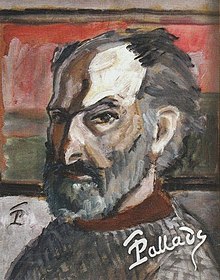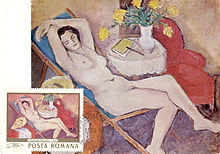Theodor Pallady


Theodor Pallady(Romanian pronunciation:[teˈodorpaˈladi];11 April 1871 – 16 August 1956) was aRomanianpainter.
Biography
[edit]Theodor Pallady was the son of Ioan Pallady and Maria Cantacuzino, the older sister of Romanian diplomat Neculai B. Cantacuzino. He was born inIași,Romania on April, 14th 1878 and spent his childhood both in Perieni and in Iași.[1]At a young age, his family sent him toDresden,where he studiedengineeringat theDresden University of Technologybetween 1887 and 1889. At the same time, he studied art withErwin Oehme,who, recognising his artistic intuition, suggested that he go toParis.[2]
In Paris, Pallady worked in the studio ofEdmond Aman-Jeanand enrolled in theAcademy of Fine Arts(Académie des Beaux-Arts). In 1892 he joinedGustave Moreau’s studio where he worked alongside painters such asHenri Matisse,with whom he developed a close friendship,Georges Rouault,andAlbert Marquet.[3]
In 1900, he presented his work "The Prodigal Son", at theExposition Universelle,which earned him high praise.[2]
In 1906 he married Jeanne Ghika-Brigadier.[4]
He opened a studio in Paris onPlace Dauphine,where he worked until 1940, traveling often between France and Romania.[2]
In 1904, Pallady returned to Romania, where he held an exhibition at theRomanian Athenaeum.However, he maintained close connections with Paris, where he continued to hold many personal exhibitions, up untilWorld War II.[5]
Pallady never lost the contact with Romania and had friends from the community of Romanian artists and intellectuals living in Paris, includingBenjamin Fondane,George Enescu,Constantin Brâncuși,Camil Ressu,Nicolae Dărăscu,Panait Istrati,Traian Vuia,Eugène Ionesco,Emil Cioran,andPaul Celan.Theodor Pallady bought the firstBrâncușiKisssculpture, a small version (7.8 "× 1.18" × 1.57 ") in pink marble. This sculpture is dated 1905 and was brought with him to Romania. He also exhibited at theVenice Biennalein 1924, 1940 and 1942.

In 1940 he moved toBucharest.[1]He died in Bucharest on 16 August 1956, and is buried inBellu Cemetery.[2]
Legacy
[edit]The Melik House, situated in Bucharest houses TheTheodor Pallady Museum,a branch of theNational Museum of Art of Romania.Here are exposed his canvas paintings, as well as 800 of landscape sketches, portraits, and still life paintings, which are representative of his Paris period. The building, built in 1750 by Hagi Kevork Nazaretoglu, is the oldest house in Bucharest. In front of the museum's building stands a bronze statue of Theodor Pallady, created by the Romanian sculptor Gheorghe D. Anghel.[6]Other works of Pallady's are features of the National Museum's main collection, at Bucharest'sZambaccian Museum,thePalace of CultureinIași,theArgeș CountyMuseum inPitești,theBrukenthal National MuseuminSibiu,and theCraiova Art MuseuminCraiova.
References
[edit]- ^abGeorgescu, I.L. (1998).Pe urmele lui Theodor Pallady.Bucharest, Romania: Lumina Lex.ISBN9735881373.
- ^abcd"Theodor Pallady, pictorul uitat al Iașului".ziarullumina.ro.Retrieved4 December2019.
- ^Pallady, Theodor (2009).Pallady scriind: jurnale, scrisori, însemnări.Compania.ISBN978-973-7841-67-4.OCLC741721824.
- ^Chiper, Mihai (2016).Pe câmpul de onoare: o istorie a duelului la români.Bucharest:Humanitas.ISBN978-973-50-5471-7.OCLC1108180328.
- ^Enescu, Theodor (2003).Pallady, Theodor.Oxford Art Online.Oxford University Press.doi:10.1093/gao/9781884446054.article.t064896.
- ^"Muzeul Theodor Pallady - Bucuresti".ghidul.ro.Retrieved4 December2019.
External links
[edit]- Theodor Palladyon ArtFact.
